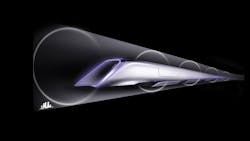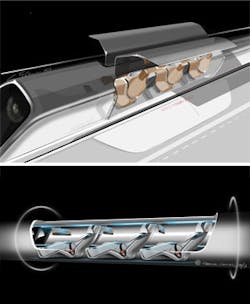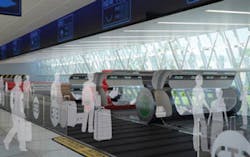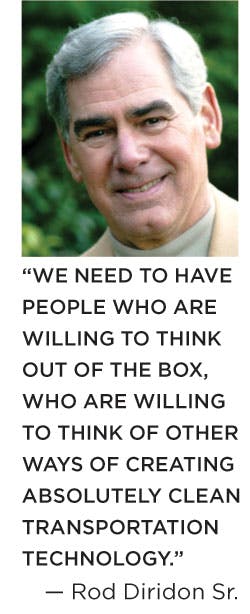Passengers mill around the San Francisco platform, charting arrivals on their smartwatches.
The digital interfaces harmoniously display the passing of the hour -- 5 p.m. -- and simultaneously a pod -- a pressurized capsule -- zooms into the station.
Twenty-eight passengers climb in, each carrying no more than two bags apiece. For $20, they are headed home to Los Angeles after work.
The solar-powered capsule leaves the station, followed 30 seconds later by another same-sized pod. And so on into the low-pressure tubes. Like clockwork.
The pod zips along the countryside at speeds of up to 760 mph, elevated above the highways and free of the congestion below.
Thirty-five minutes later, the passengers pour out of the driverless pod, in Los Angeles, nearly 400 miles away from their launch point.
Another group piles on and the 4-by-6-foot capsule shoots into the tube, precisely 23 miles ahead of the next one, in perpetuity, transporting 840 passengers per hour.
This is the Hyperloop.
Revered by some as the future of transportation and dismissed by others as a new iteration of a pie-in-the-sky idea around for decades, the Hyperloop as proposed by Elon Musk has the potential to disrupt the world of transportation.
See Also: Manufacturing Innovation & Product Development Strategy
It could assuage overcrowding at airports by eliminating the need for regional flights, derail costly plans for high-speed rail, and reduce dependence on gas-guzzling automobiles.
It could change everything.
Musk may not deliver a fifth mode of transportation; he may not reinvent long-distance, high-speed ground travel; he may not singlehandedly revolutionize mass transit.
But he has given the world hope.
Make It Work
"Short of figuring out real teleportation, which would of course be awesome (someone please do this), the only option for super-fast travel is to build a tube over or under the ground that contains a special environment," Musk, the CEO of SpaceX and Tesla Motors, writes in the 58-page concept paper on "Hyperloop Alpha" that he pounded out one night.
With his Hyperloop concept, Musk, a pioneer of commercial space flight and the mind behind a new class of electric car, is challenging the world to do better, to think bigger, to bring the unthinkable to reality.
"Elon is a force of nature, and he's done some things that many people would have considered impossible," says Rod Diridon Sr., executive director of the Mineta Transportation Institute, a research institute housed at San Jose State University.
Diridon says he is certain that the Hyperloop, with Musk's support, can transition from a technological pipe dream to a viable tube reality and join the ranks of Musk's successes.
"I think that if he really thinks he can do it and is willing to invest, others will have confidence and be more willing to help him," says Diridon, who is known as the father of modern transit in Silicon Valley.
Without Musk's investment of time and resources, the $6 billion project likely will go the way of Germany's maglev -- magnetic levitation -- high-speed train, he says. Abandoned. A powerhouse country committed to sustainable transportation initiatives couldn't find a way to financially make the project work.
Because, as Diridon asks, without Musk and his commercial spacecraft, electric sports cars and electric luxury sedans, who else is there?
Power of the Crowd
Dirk Ahlborn, CEO and co-founder of JumpStarter Inc., hopes he has the answer with his new crowd-sourced and crowd-funded platform JumpStartFund.com.
JumpStarter, with Musk's approval, has pitched the Hyperloop concept on its platform, inviting the crowd to help develop and finance the project.
"I do believe that there's this huge power that lies in the crowd," says Ahlborn, a self-identified serial entrepreneur who started the company as a way to give entrepreneurs the resources they need to develop their visions.
The JumpStartFund.com process, he says, is designed to recreate the kind of intellectual community that emerges when great minds are contemporaries, as in the 1800s with the likes of Thomas Edison, John Rockefeller and Nikola Tesla. Its goal is to free would-be entrepreneurs from the constraints of running a business, which he says can derail even the best ideas, and instead allow them to innovate.
"If it fails, then it's still a success," Ahlborn says. "What we're doing is we're actually trying. It doesn't mean you have to be successful. Personally, I believe there is no technical challenge that can't be solved."
Cost of Innovation
But it's not the technical side of the equation that concerns Diridon.
It's everything else.
JumpStarter certainly isn't alone in embracing the crowd for crowd-sourcing and crowd-funding. Companies like Kickstarter, which offers a crowd-funding platform for creative projects, have been embraced with open arms.
However, even with its great success, Kickstarter has only collected $843 million since its launch in 2009. And that total supports 50,000 different projects. There's nothing on the scale of what JumpStarter is proposing with the Hyperloop.
While Diridon is skeptical that a project as massive as the Hyperloop can gain traction without the likes of Musk, he does hold out hope that Musk's support of it -- and the way his backing has propelled the project into the limelight -- will inspire others, either to develop the Hyperloop or to craft their own breakthrough transportation idea.
"We need to have people who are willing to think out of the box, who are willing to think of other ways of creating absolutely clean transportation technology," Diridon says. "Who knows what that might be in the future?"
Even Joe Boardman, CEO of Amtrak, says the company, if it had unlimited resources, would probably pursue an idea like the Hyperloop.
However, he says Amtrak can't ignore the immediate transportation issues facing the rural parts of the country where bus and aviation services are being abandoned.
"We have to deal with what we have for infrastructure today," Boardman says. "What we really find today is the need to continue to operate on the existing infrastructure to meet the needs today."
On the Rails
Development of the Hyperloop wouldn't require unlimited resources, but it would be expensive.
Musk's estimated $6 billion price tag for the Hyperloop puts its cost well below that of the $68.4 billion California High-Speed Rail project, an 800-mile endeavor that the billionaire engineer has publicly criticized.
"The underlying motive for a statewide mass transit system is a good one," Musk writes in his Hyperloop paper. "It would be great to have an alternative to flying or driving, but obviously only if it is actually better than flying or driving. The train in question would be both slower, more expensive to operate (if unsubsidized) and less safe by two orders of magnitude than flying, so why would anyone use it?"
The figures proposed by Musk have been widely questioned as being too conservative.
"Everyone knows the estimates are terribly low," Diridon says. "You don't know how much it's going to cost because no one's ever built one."
And building the Hyperloop will involve much more than honing the technology and finding financing.
First, a demonstration model will need to be crafted, then a demonstration system, before an actual working system can be put in place. And without any actual experience with a working Hyperloop on which to base cost estimates, any pricing numbers will be speculative, Diridon says.
(Im)possible Dream
However, despite the inevitable hurdles, Diridon has hope for the Hyperloop because of Musk's influence.
There have been other disruptive ideas like the Hyperloop before, using similar technologies.
Lockheed Martin a decade ago experimented with a high-speed maglev system in California.
And in Colorado, ET3, for Evacuated Tube Transport Technologies, has been exploring vacuum maglev trains that its founder Daryl Oster suggests will one day cross the globe at speeds of up to 4,000 mph, creating what the company calls "space travel on Earth."
But, the difference this time could be with Musk.
| Check out iw.com/crowd to learn about other crowd-sourcing efforts. |
"This isn't a new idea, but Elon has such a record for accomplishing the impossible," Diridon says. "If he decides personally to become involved in creating this concept, then, with his intellect and wealth, there's a chance of it happening in the next couple of decades."
Musk has said he is too busy with his commitments to SpaceX and Tesla to pursue the Hyperloop. But …we'll see.
About the Author
Ginger Christ
Ginger Christ, Associate Editor
Ginger Christ is a former associate editor for EHS Today, a Penton publication.
She has covered business news for the past seven years, working at daily and weekly newspapers and magazines in Ohio, including the Dayton Business Journal and Crain's Cleveland Business.
Most recently, she covered transportation and leadership for IndustryWeek, a sister publication to EHS Today.
She holds a bachelor of arts in English and in Film Studies from the University of Pittsburgh.




